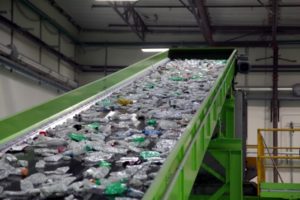
For nearly 50 years, Adams Plastics has led the way among plastic recycling companies, committing our Recycling Division to providing fair recycle prices and keeping plastic materials available for reuse instead of lining landfills. Materials often come from post industrial and consumer environments, including parts, scrap, purge, or chunks.
Our recycling process includes grinding, sorting and bailing. Once recycled and ready for reuse, Adams Plastics sells materials both domestically and internationally.
An Overview of Recycling Plastics
According to the Environmental Protection Agency, only 8.7 percent of the plastic produced in 2018 got recycled. While some particular types of plastic, like PET bottles and jars, had a higher recycling rate, there’s still plenty of room for improvement. At Adams Plastics, our Recycling Division has been keeping plastic out of landfills and making it available for reuse for about 50 years.
Plastic Recycling Process
There are six general steps in the plastic recycling process. It’s important to review these to ensure you’re taking the necessary measures as a consumer before you send your recycling out to local collection services or bring it to designated facilities, as every place is different and may not accept everything. You can contact Adams Plastics directly to learn more about their specific plastic recycling process.
- Collection: Recyclable plastics must be collected from consumers. Many city governments have a collection service. You may also be able to take your recyclables to a designated facility or you can work with a private company that offers collection services.
- Sorting: Before recycling, plastics must be separated by type and, in some cases, by color or thickness. It’s also important to sort out any other materials, like cardboard or non-recyclable plastic, that may have been thrown into the same container.
- Washing: Dirt, chemicals, labels and adhesives, and food residue can ruin freshly recycled plastic, forcing it to be thrown away after all. By washing your recyclables before sending them to the recycling facility, you aid this cleaning process.
- Shredding: Breaking down the plastic into smaller pieces prepares it for processing and reuse. During this step, additional contaminants can be removed.
- Identification and Separation: By floating plastic pieces in water or sending them through an air tunnel, the plastics can be separated by class and quality.
- Compounding: The plastic particles are melted together and turned into a new plastic product.
When you look at your plastic products, you’ll notice a number indicating the type of plastic. There are three primary types of recyclable plastic: Number 1, polyethylene terephthalate (PET), Number 2, high-density polyethylene (HDPE), and Number 3, plasticized polyvinyl chloride (PVC). Products like milk jugs, juice and other beverage bottles, shampoo bottles, toys, pipes, and more are typically made of these plastics.
Plastics Number 4, low-density polyethylene (LDPE), Number 5, polypropylene (PP), and Number 6, polystyrene (PS) are also recyclable, but they are more difficult and/or costly to recycle, and not all facilities are willing to handle them. Your local government or private company recycling guidelines will tell you which plastics are recyclable in your area.
Importance of Plastic Recycling
Plastic products are overtaking landfills and polluting our water and soil. The demand for plastic products, from disposable water bottles to diapers, toys, and trash bags, is on the rise. In 2018, the United States alone produced 35.7 million tons of plastic products—27 million tons of which ended up in the landfill. These numbers highlight why plastic recycling is so important, but there are many reasons to do so:



